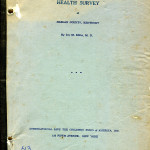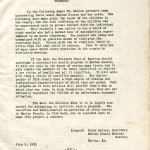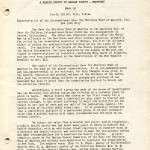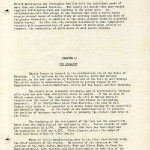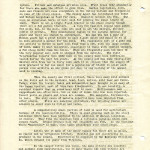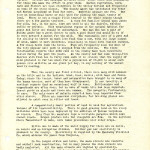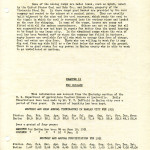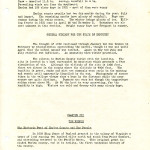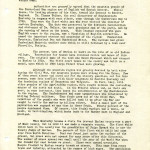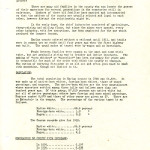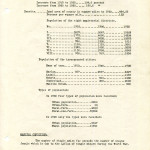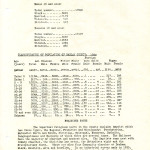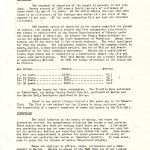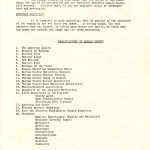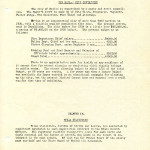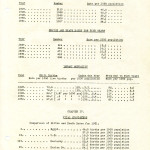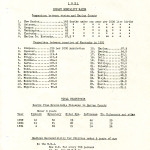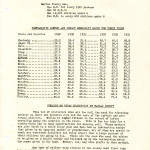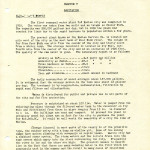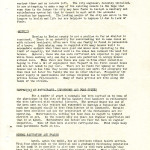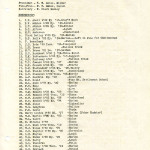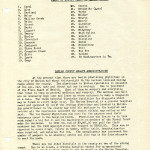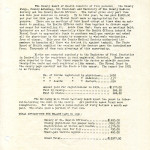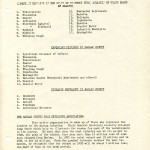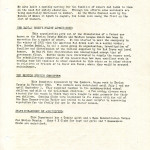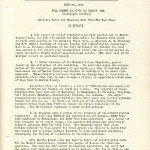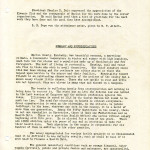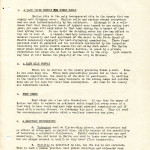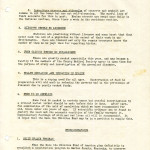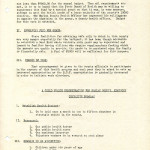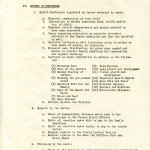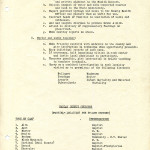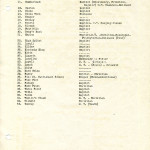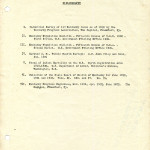Pine Mountain Settlement School
Series 14: MEDICAL
Series 18: PUBLICATIONS RELATED
Dr. Iva Miller for Save the Children Foundation
Health Survey of Harlan County
Includes Members of the Harlan County Medical Society
1932
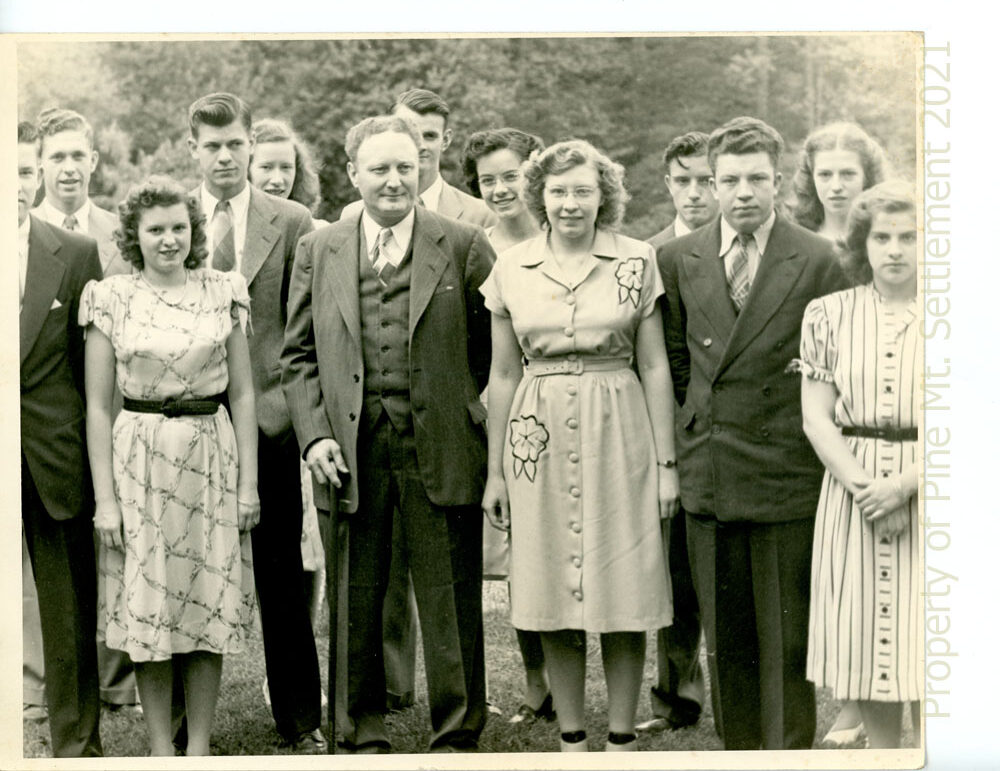
008 Baccalaureate 1947. Densal [Denzal] Duncan, Lonnie Lewis, Wanda Collier, Bob Calloway, Gladys Caroll, Dr. Clark Bailey [Trustee and Physician], Jack Wilder, Beth LaRue, Grace Tyree, Roy Banks, Arch Lewis, Jolene Lucas, Janey Lou Blanton.[097_students_008 008 [B-2427]
TAGS: studies, reports, Dr. Iva M. Miller, Health Survey of Harlan County, Great Depression, Save the Children Fund of America, community, coal camps, doctors, churches, diversity, Katherine Pettit, health education, medical satellites, nurses, teachers, industrial training, Isabella Fisher Hospital, Clark Bailey, Harlan County Medical Society
PUBLICATIONS RELATED 1932 Dr. Iva Miller Health Survey of Harlan County
By IVA M. MILLER, M.D., Representative of the INTERNATIONAL SAVE THE CHILDREN FUND OF AMERICA, INC., NYC***
Have you ever wondered what health care looked like during the Great Depression in Harlan County, KY? This 1932 Health Survey of Harlan County, Kentucky by Iva M. Miller, M.D., a representative of the International Save the Children Fund of America, Inc., with the cooperation of the physicians of Harlan County, provides a window into the county from c. 1930-1932. How does Harlan County compare today?
The Survey is more than just a Health Care survey. It also captures a glimpse of the people, the coal camps, the doctors, the churches, and the diversity of the county during a challenging period in the history of this country. It is a comprehensive resource for information about the county during hard times and includes recommendations for addressing county-wide problems.
The following copy of HEALTH SURVEY OF HARLAN COUNTY, KENTUCKY by Iva M. Miller, M.D., belonged to Katherine Pettit, one of the founders of Pine Mountain Settlement School. Health education was at the center of Pettit’s program for Pine Mountain Settlement. She was successful in establishing two medical settlement satellites not far from the central settlement at Pine Mountain. The Medical Settlement at Big Laurel and Line Fork Settlement were small facilities staffed with a physician, a nurse, and generally an Industrial Training teacher. The satellites were focused on providing medical assistance and industrial training for the surrounding community from approximately 1919 until the mid-1940s.
ABOUT Iva M. Miller
Iva Myrtle Miller (1880-1951) [married Wm. M. McFadden, 1912] . Miller was a Public Health worker and was charged with managing the study in Harlan County. She was previously the medical director of the Isabella Fisher Hospital in Tientsin, China, from 1910-1930 where she helped to direct public health and hygiene campaigns for the Chinese Nationalist government.*** Not unlike her recommendations for public health campaigns in eastern Kentucky, her work in China emphasized health education. Photographs of her work in China were acquired by the Hoover Institution Archive at Stanford University in 1972. She was a graduate of Stanford University [A.B. Ger., May 1907].
***See: Nakajima, Chieko. “Twentieth-Century China,” Volume 34, Number 1, November 2008, pp. 42-72.
See also: Isabella Fisher Hospital in Tientsin, China, from 1910-1930
Stanford University
Hoover Library
http://pdf.oac.cdlib.org/pdf/hoover/72061.pdf
for information and photographs regarding Iva M. Miller
**Permission to reproduce the 1932 Harlan County Health Survey in Pine Mountain Settlement School Collections was granted March 13, 2016, by digitalchampions@savechildren.org.
TRANSCRIPTION: Forward by Clark Bailey, M.D.
Forward by Dr. Clark Bailey, Secretary Harlan County Medical Society and member of the Pine Mountain Settlement School Board of Trustees.
FORWARD
In the following pages Dr. Miller presents some interesting facts about Harlan County and her needs. The following data make plain the needs of the children in the county, but the real suffering of the children can be appreciated only by actual contact with the individual cases. Only recently I was called to see a child of eight months who had a marked case of malnutrition superimposed by an acute diarrhea. The parents are young and unemployed with no possible means of supplying the necessary food. Unless milk can be supplied, there is little hope for that child to recover. This is only one of many cases which every physician in the county is constantly meeting.
If the Save the Children Fund of America should undertake a constructive health program in Harlan County, it will not only be the means of saving many lives, but it will enable the members of the homes benefited to receive a new vision of health and all it signifies. It will also give them a vision of unselfish mankind. The native people of this county have a high degree of stamina and independence characteristics of which they are proud. Such a program as is here outlined will provide them a way by which they can learn to help themselves, since they are not naturally dependent but victims of an unfortunate economic situation.
The Save the Children Fund is to be highly commended for attempting to institute such a program. Further, the unselfish and whole-hearted co-operation of every doctor in Harlan County in this work, can be depended upon to make this project a success.
(signed) Clark Bailey, Secretary
Harlan County Medical Society
Harlan, KY
July 5, 1932
TRANSCRIPTION: PUBLICATIONS RELATED 1932 Dr. Iva Miller Health Survey of Harlan County
A HEALTH SURVEY OF HARLAN COUNTY – KENTUCKY
Made By
Iva M. Miller, M.D., C.P.H.
Representative of the International Save the Children Fund of America, Inc.
New York City
[page 01] The Save the Children Fund of America is the American Unit of Save the Children International Union which has its headquarters in Geneva, Switzerland. The Union was organized shortly after the World War by Officials in the Red Cross and other welfare agencies, primarily for relief in the devastated countries in Europe. but with the ultimate object of aiding the underprivileged children of all the lands of the earth. Its manifesto of the Rights of the Child, popularly known as the Geneva Declaration, has been approved by the League of Nations and signed by representatives of countries, including King Boris of Bulgaria, and has even, been incorporated in the Constitution of the New Spanish Republic as Act. XLl.
The object of the International Save the Children Fund of America is the same as the parent organization. It is non—denominational and non—controversial in its attitude, the only thought being given to the health, education and general welfare of the children of the world. This year the distress among children in unorganized sections of our homeland has been so great that the organization has decided to devote all its attention thereto.
Accordingly, brief survey was made of the areas of unemployment and the Kentucky coal mining region was selected as a suitable place in which to begin. Harlan County was chosen the first county for a health survey. In order that a constructive plan might be started and carried through, it deemed necessary to major our activities at the
outset on one type of work and one unit of the population, namely, the health needs of children under school age. It is generally recognized that a qualitative analysis of a particular group is of more permanent value that a general survey with vague recommendations followed by uncertain results.
To insure its value from a medical and public health standpoint, a public health doctor who had spent many years in China in medical and health education, with an additional broad experience in curative work in a hospital and health centers, was selected to make the preliminary survey and make recommendations for a constructive health program. A local committee know as the Harlan County Committee of the Save the Children Fund of America had already been appointed to represent the organization in New York.
Its members were: Rev. C. E. Vogel, pastor of the Methodist Church; Rev. R.A. Matheny, pastor of the Christian Church; Rev. W.J. Bolt, pastor of the Baptist Church; Mrs. Bertha Bedell, Social Service Worker for the Red Cross (ex-officio); Mrs. E.V. Albert member of the Parent Teachers Association in Harlan; Mrs. E. T. Hicks, a nurse and Mr. L.A. Billips, a business man and member of the City Council. Five of them are active members of the Distribution Committee of the Harlan County … [page 02] Relief Association and thoroughly familiar with the individual needs of more than one thousand families. For nearly six months they have worked together distributing food and clothing to the needy ones. In collaboration with this group, it was decided that such a survey would require several weeks of careful study of existing conditions and also of the people themselves, in addition to the usual elements found in a general health survey. To this end, the surveyor determined to make sympathetic contacts with representatives of each element of which local society is composed, the combination of which helps to mold public opinion.
CHAPTER I. THE LOCALITY
Harlan County is located in the southwestern tip of the State of Kentucky. It is bordered on the north by Leslie, Perry and Letcher counties, on the east and south by Virginia and on the west by Bell County. The entire county is mountainous, traversed by several ranges of the Appalachian chain, called Cumberland, Little and Big Black, and Pine Mountain.
The county is an irregular rectangle, and is approximately thirteen miles wide and more than thirty -five miles in length. It has an area of 484.56 square miles. The county seat is the city of Harlan which is located near the center of the county in a bowl formed by surrounding mountains. It is thirty-three miles from Pineville, the seat of Bell County, with which it is connected by a double track railway of the Louisville and Nashville System. At the forks of the Cumberland River it occupies the position of business center to what is probably the richest coal area in the state.
The beginning of the development of the town and the coal-fields dates from the completion of the railroad in 1911. Census records of 1920 give a population of 2,647. Growth since that date has been rapid and the population in 1930 was 4,327. These figures include the camps of three coal mines within the city limits.
There is little manufacturing done in the city, coal-mining being the chief industry of the region, On account of its location at the junction of the three forks, Martin’s Poor and Clover Fork, to form the Cumberland River, with railroad and mine developments on each side of the forks, the city is warehouse, wholesale, repair shop and residence as well as business center of the district. Below Harlan and less than a mile from the city limits is the town of Baxter at the junction with the Poor Fork branch of the Louisville and Nashville railway. Immediately below Baxter are the New L & N yards with[in] the town of Loyall. An engineer who [page 03] has made a study of the situation in Harlan over a period of years predicts that communities are destined to line up with the larger city as are also additional mining communities on Clover Fork and Martin’s Fork and all together form a community of something like 8000 inhabitants.
All the principal streets in Harlan are paved with concrete and rock asphalt materials and there are four concrete bridges over the various streams within its limits. The State highway is a concrete road connecting it with Pineville and with Dixie Highway Route 25. The state highway is part of the Mayo Trail. Very soon it is expected that Harlan may be on the west branch of the Appalachian Way.
There are three bus lines operating regularly in the county. In addition to Harlan there are four other incorporated cities in the county: Loyall, Evarts, Cumberland and Wallins Creek. The majority of the other towns in the county are also mining camps as: Lynch, Benham, Alva, Molus, Insull, Twila, Elcomb, Bardo Liggett, Yancy, Lenarue, Coalgood, Kilday, Louellen, Kenvir, High Splint, Closplint, Cawood, Kitts Putney and Shonn.
The topography of the county is similar to that found in any mountainous area. The mountains form long ranges with narrow irregular valleys between them. The slopes are steep. The contour is inclined to be peaked though occasionally a round-topped mountain is visible. There is little level land. The beauty of the mountains is further enhanced by thick forests. In many places it has been found necessary to clear the trees by burning and uprooting them to find space for growing beans and corn and other garden vegetables.
The elevation of the county has a wide range. In Harlan, which is not by any means the lowest, it is 1199 feet and the highest point in Black Mountain is 3700 feet. The soil is very fertile and productive. It has a top-soil which is either black or sandy loam.
In the mountain the sub-soil is filled with silica and frequently line-stone on a base of slate. Below the slate is often found rich deposits of bituminous coal. These coal seams are from 42 to 144 inches in thickness. Up to the present no gas or oil has been found in this county.
There are no lakes in the county except a small artificial one located a few miles west of Harlan city. The Cumberland River is the only large stream and it is made up of the three Forks which rise in Virginia and unite in and near Harlan, two of them Clover Fork and Martin’s Fork, unite at Harlan while Poor Fork joins them a short distance below. The rate of flow in the river is very rapid and the general direction toward the west. In spite of the abundant rainfall, much of the year the river bed is very low, at times in June and July, it is scarcely covered by water. In spite of this fact, floods have occurred in the past which threatened to wash away hundreds of buildings. Until these rivers are harnessed down and the waters utilized to furnish some type of manufacturing power, that danger will always exist.
Many of the mountains are deeply wooded, doubtless all would be, had they not been cleared for planting crops. Trees commonly seen are; soft and hard maple, ash, hickory, sycamore, hemlock, fir, pine, birch and [page 04] spruce. Willows and catalpas are also seen. Fruit trees bear abundantly for those who make the effort to grow them. Garden vegetables, corn, oats and flowers are seen everywhere in the valley bottoms and frequently on some of the steep slopes. The County Agent has introduced soy beans and Korean Lespideza [sic] as food for cows. Domestic animals are few. One sees an occasional horse and mule used for plowing the small tracts of land. There is not a single field tractor in the whole county though there are a few garden tractors. A very few families depend upon goats for milk, but, in the main, cows are used in all the dairies, whether public or private. This mountainous region is the natural habitat for goats and their use should be encouraged. One man who has a pair of Nubian goats has a great desire to open a goat diary and would do so it he were assured a market for the milk. The reasonable cost of a goat and its ability to thrive on much less food than a cow, with its large output of milk, makes it most desirable, especially to those with limited incomes. A few sheep herds roam the hills. Pigs are frequently seen but most of the popular salt pork is shipped from the outside. The state Veterinarian reports that 1023 cows in the county have been tuberculin tested during the past two years. As the county now has some twenty-five dairies with from ten to forty cows each it is evident that the supply of milk produced is far too small for a population of 65,000 to allow each person even as little as one glass per day, to say nothing of the amount used in cooking.
When the county was first settled, there were many wild animals on the hills and in the hollows: bear, deer, wolves, wild boar and foxes. Today, since the trains, buses and automobiles have brought in so many of the human species, most of them have disappeared. In one locality, a resident reports that an occasional wold is seen. Rattlesnakes and copperheads are often seen, but no case of snake bite has been reported. Insect pests on plants and trees are common. The mosquito, fortunately is rare. The only cases of malaria reported have been imported from other states. Flies are numerous everywhere, for breeding places are allowed to exist even in cities and towns.
A comparatively small portion of land is used for agriculture because of its inaccessibility. There is good grazing land on the steep hillsides which have been improved by the addition of Korean lespideza [sic] or clover. They find the mountain tops a veritable paradise which cows cannot reach. Grapes produce well but vineyards are few. In the sections where “moonshine” is made, corn takes precedence over other crops.
Little use is made of the water supply for there are no mills, no canals, and no irrigation ditches. Neither gas nor electricity is produced in the county. Electricity is supplied by the Kentucky Utilities Co. which obtains its power from Virginia.
In the larger cites and town, the main streets are concrete and asphalt rock construction, but in many places the side streets are badly neglected. All the main streets are lighted by electricity. Electricity is supplied to all houses for lighting purposes and for kitchen use to those who prefer to pay the price which is higher than coal.
[page 05] Some of the mining camps are model towns, such as Lynch, owned by the United States Coal and Coke Co. In these maps good houses are provided by the coal company and rented to the miners at a nominal price. They are usually built adjacent to the mine and its coal conveyor, which sends the coal to the tipple in which the coal is screened into its various sizes and loaded on the cars for shipping. In some of the camps, houses are roomy and fitted with all the modern conveniences. Others are not so large but all are comparatively new and keep in repair far better than the usual housing to be found in any large city. In the abandoned camps where the vein of coal has been “worked out” or where the company has failed in business, empty houses are available for all who wish to occupy them free of charge. Coal and water are also free. Those who are willing to work for it may dig coal from any side hill or a few feet below the surface of the ground. There is no good reason for any person in Harlan county who is able to work to go unsheltered or unclean.
CHAPTER II. THE CLIMATE
This information was secured from the Kentucky section of the U.S. Department of Agriculture Weather Bureau at Louisville. Daily observations have been made by Mr. W.W. Duffield in Harlan city over a period of four years. No record of humidity has been kept.
MONTHLY AND MEAN ANNUAL TEMPERATURE IN HARLAN CITY FOR 1931
Station Harlan
| Jan | Feb. | Mar. | Apr. | May. | Jun. | Jul. | Aug. | Sep. | Oct. | Nov. | Dec. | Mean | |
| 36.5 | 36.6 | 38.1 | 51.9 | 59.6 | 71.4 | 77.2 | 71.4 | 72.6 | 59.4 | 53.6 | 49.1 | 56.4 |
MAXIMUM for Harlan has been 98 on June 18, 1931
MINIMUM for Harlan has been 10 on Jan. 2, 1931
MONTHLY AND ANNUAL PRECIPITATION FOR 1931
Station Harlan
| Jan | Feb. | Mar. | Apr. | May. | Jun. | Jul. | Aug. | Sep. | Oct. | Nov. | Dec. | Total | |
| 1.67 | 2.52 | 3.88 | 5.96 | 4.45 | 3.03 | 5.96 | 7.40 | 1.60 | 1.58 | 1.96 | 7.05 | 47.06 |
MINIMUM precipitation in October 1.58 inches
[page 06]
Snow – unmelted 11.5 in. Average snowfall is 4 in.
Prevailing winds are from the southwest.
Harlan had 126 clear days in 1931 – most of them were sunny
Harlan County usually has two dry months during the year, July and August. The remaining months have plenty of rainfall. Fogs are common during the rainy season. The winter brings plenty of ice. Killing frosts in 1931 came in April 28 and November 5. Tornadoes are almost unknown in this section. Bright sunny days are frequent in summer.
GENERAL SUMMARY FOR THE STATE OF KENTUCKY
The drought of 1930 continued through January but was broken in February by precipitation approaching the normal, though it was not until April that the normal amount was reached. Again n May and June and July rainfall was deficient. An unusually warm winter prevailed.
The climate in Harlan County varies with the locality. The city is located in a bowl surrounded by mountains which prevents a free circulation of air. Although the altitude of the city is 1200 feet, there are places in the county where the altitude is 4200 feet. The humidity is great, smoke and mist are commonly seen early in the morning and remain until apparently dispelled by the sun. Photographs of scenes taken in the valleys always show a haze in the distance while the near scenes are quite distinct. Summers are very hot though the temperature seldom rises above 98. At 80 the heat is very enervating, for the humidity is high. Winters are cold and dreary with many cloudy days.
CHAPTER III. THE PEOPLE
The Historic Past of Harlan County and Her People
In 1609 King James of England granted to the colony of Virginia a tract of land running two hundred miles north and south from Point Comfort and stretching westward to the Pacific Ocean. [Granville Tract] the original grant included Harlan county, and is in reality, the first authentic history of the county. [? authentic]
After the Revolutionary War, Kentucky county was set off from Virginia, its area probably including what is now Kentucky, Ohio, and Tennessee. Some surveys were made before the War but the territory was [page 07] not thoroughly explored until after the War when Daniel Boone and Dr. Walker came.
Authorities are generally agreed that the mountain people of the Cumberland Gap region are of English and Scotch descent. Daniel Boone, the leading pioneer of his time, traced his descent to Exeter, England. Dr. Thomas Walter, the real discoverer of Southeastern Kentucky in company with some others, came through the Cumberland Gap in 1750. They were the first white men who ever visited the interior of eastern Kentucky. The date was preserved by the distinct recollection and statement of Dr. Walker, the most prominent man of the party, and by the carving of dates on the trees. This learned explorer who gave English names to the region was a Virginian of English extraction. He named the important streams and mountains of the region: Cumberland Mountain, Cumberland Gap, and Cumberland River. The Indians had given Cumberland Mountain another name which is still retained by a town near Pineville, Wasioto.
The present town of Harlan is built on the site of an old Indian village. Excavations for houses have revealed relics and bones of this race. The original name of the town was Mount Pleasant which was changed to Harlan in 1912. The first court house in the county was built on a mound, upon which in 1908 large forest trees were growing.
Although the mountain region was greatly desired by both sides during the Civil War, the mountain people were strong for the Union. Few of them owned slaves and cared not for the slavery question, and for this reason, came into conflict with their neighbors in Central Kentucky and the bordering regions of Tennessee and Virginia. In fact, they, with other peoples of the Appalachian region, were caught between the contending armies of the north and south. In the Federal armies and, on their own part, in some instances, they began the extermination of the Confederates in the region. The Confederates had some sympathizers who retaliated by killing Federal soldiers. Thus feuds grew out of the Civil War. The relatives of the people who were killed took it up after the War and sought to settle the matter by killing others. Only a small part of the population was engaged at any time in these feuds. Ninety percent of the people condemned them. Of course, this feud warfare has a basis, no doubt, in individualism, which harks back to the Border wars in England and Scotland.
When Kentucky became a state the present Harlan county was a part of Knox County, but in 1819 it was made a separate county. The first white child born in the county was the grandfather of Judge Howard who is now the County Judge of Harlan. The parents of the first white child had come over from North Carolina. Coal was found just under the surface of the ground, but mines were not opened for many years after this discovery. The number of mines opened was small until the year of the World War when the demand for coal became so great. Mines were opened overnight. People flocked to Harlan county to work as miners. They came from every trade and industry, attracted by the rumors of high wages. The population almost doubled in a few years. Wages were high and money was plentiful and free. No one thought of saving. Gardens were rare, for why should a man who worked long hours in the mine during the day make a garden at [page 08] at night when vegetables were being shipped in an abundance at reasonable prices?
There are many old families in the county who can locate the graves of their ancestors for several generations in the cemeteries still in existence. Members of these old families have married and intermarried so that the natives of the county are unusually related and loyal to each other, however distant the relationship might be.
In the early days, the chief industries consisted of agriculture, sheep-raising and milling flour, but since the mines were opened, every other industry, with few exceptions, has been neglected for the one which produced the largest income.
Harlan County existed without a railroad until 1911, and trails were in common use as roads until four years ago when the first highway was built. The usual modes of travel were by wagon and on horseback.
Feuds between families were common in the past and some still exist, but are gradually giving way to broader and better interests. The making of “corn whiskey” or “moonshine” has been customary for years and is responsible for much of the crime with which the county is charged. The custom of carrying fire-arms is an old one and often goes hand in hand with moonshine, though not limited to it.
POPULATION
The total population in Harlan County is 1930 was 64,557. It was made up of native-born whites, foreign-born whites, those of mixed parentage, and Negroes. The native-born whites are the true mountaineers whose ancestors settled among these hills and hollows more than one hundred years ago. Of this group, 57,819 persons are native white but not all of native parentage: other have foreign and some mixed parentage. Negroes number 5,879 and those of other races are given as 37. There are no Orientals in the county. The percentage of the various types is as follows:
Native white ……………………….89.6 percent
Foreign-born white …………….1.3 percent
Negro ……………………………….. 9.2 percent
The Census records give for 1920:
Native white ………………………. 86.8 percent
Foreign-born white ……………. 4.0 percent
Negro ………………………………….. 9.2 percent
POPULATION OF COUNTY WITH INCREASE
In 1890 …………………………6,197
In 1900 …………………………9,838
In 1910 ………………………..10,566
In 1920 ………………………..31,546
In 1930 ………………………..64,577
[page 09] Increase from 1910 to 1920 …… 104.6 percent
Increase from 1920 to 1930 …… 198.6 percent
Density …..Land area of county in square miles in 1930…484.56
Persons per square mile ………………………………133
Population of the eight magisterial districts
No 1910 1920 1930
| I | 2537 | 2647 | 19229 |
| II | 1773 | 4696 | 14924 |
| III | 932 | 9835 | 12582 |
| IV | 796 | 1336 | 1616 |
| V | 1118 | 1118 | 2661 |
| VI | 1340 | 1450 | 5592 |
| VII | 1135 | 3734 | 6549 |
| VIII | 935 | 919 | 1404 |
Population of the incorporated cities:
Name of town 1910 1920 1930
| Harlan | 657 | 2647 | 4327 |
| Loyal | …. | …. | 1468 |
| Evarts | ….. | 502 | 1438 |
| Cumberland | …. | 300 | 2639 |
| Wallins Creek | …. | …. | 900 |
Types of population:
In 1930 four types of population were recorded:
Urban population …………………6966
Urban – farm ………………………… 12
Rural – farm …………………………..4623
Rural – non-farm …………………52968
In 1920 only two types were recorded:
Urban population ………………2647
Rural population …………….. 11941
MARITAL CONDITION
The number of single males far exceeds the number of single female which is due to the influx of single miners during the World War.
[page 10]
Males 15 and over:
Total number ……………………………………19926
Single …………………………………….. 5882
Married …………………………………. 13173
Widowers ……………………………… 598
Divorced ………………………………. 292
Females 15 and over
Total number ………………………………….17107
Single ……………………………………. 3068
Married ………………………………… 12683
Widowed ……………………………… 1092
Divorced ………………………………. 256
CLASSIFICATION OF POPULATION OF HARLAN COUNTY 1932
Age All classes Native White Foreign Born White Negro
| Age (years | Total | Male | Female | Male | Female | Male | Female | Male | Female |
| Harlan | 64557 | 33716 | 30841 | 29903 | 27916 | 595 | 227 | 3194 | 2685 |
| under 5 | 10154 | 5145 | 5000 | 4822 | 4681 | 1 | 0 | 317 | 324 |
| under 1 | 2107 | 189 | 1018 | 1036 | 960 | 0 | 0 | 52 | 58 |
| 5-9 | 10219 | 5156 | 5063 | 4831 | 4737 | 4 | 4 | 319 | 321 |
| 10-14 | 7151 | 3489 | 3662 | 3252 | 3389 | 5 | 4 | 232 | 269 |
| 15-19 | 6275 | 3035 | 3240 | 2816 | 2956 | 8 | 13 | 210 | 268 |
| 20-24 | 6433 | 3153 | 3280 | 2813 | 2929 | 20 | 13 | 318 | 336 |
| 25-29 | 6042 | 3095 | 2947 | 2612 | 2537 | 36 | 24 | 440 | 385 |
| 30-34 | 4888 | 2801 | 2087 | 2312 | 1772 | 91 | 39 | 394 | 275 |
| 35-44 | 7079 | 4120 | 2959 | 3279 | 2541 | 237 | 81 | 602 | 337 |
| 45-54 | 3860 | 2317 | 1543 | 1894 | 1395 | 157 | 32 | 265 | 116 |
| 55-64 | 1503 | 886 | 617 | 799 | 579 | 27 | 8 | 60 | 29 |
| 65-74 | 666 | 366 | 300 | 338 | 281 | 6 | 8 | 22 | 11 |
| 75 and over | 230 | 111 | 119 | 101 | 109 | 2 | 1 | 8 | 9 |
| Unknown | 57 | 42 | 15 | 34 | 10 | 1 | 0 | 7 | 5 |
RELIGIOUS SECTS
The important religious sects in the county include: Baptist which has three types, the Regular, Primitive and Missionary; Presbyterian, Methodist North and South, Christian, Episcopal, Nazarene, Catholic, Congregational and Holiness of which there are several types. The Holiness have the majority of churches and members also. The Baptists come next with twenty churches, the Christian has seven, the Methodist eight and the Presbyterians three. There are also four Community churches at Benham, Black Mountain, Alva and Louellen. In an industrial survey made in 1930, it was found that more than one-half the inhabitants in Harlan city belonged to some one of the church groups. It seems to be a code among the residents in the county that one should be a member of some church, which is not unlike many other counties in the state.
[page 11]
EDUCATION
The standard education of the people, in general, is not very high. Census records of 1930 show a fairly low rate of illiteracy of those above the age of ten years. Of the native whites, 10.6 percent were found to be illiterate, of the foreign-born whites 19.7 percent; of the negroes 12 percent. Of the total population, 10.6 percent are recorded illiterate.
The present system of education in the county comprises two groups of schools, the county public schools and five independent city schools. The former is administered by the County Superintendent of Schools under the County Board of Education. At present the County Superintendent receives his appointment from the state Department of Education. Among these schools are 67 for white and 11 for colored students. The total enrollment for 1931 was 13,000. The independent schools include the company school at Lynch, another, a home missionary project, and two at Wallins and Evarts supported by the local community government. Harlan has a consolidated county high school and is supported by a combination budget, the city and county each participating. This year Harlan county has a school population of approximately $18,000. In 1930 the school attendance in the county was as follows:
| Age Groups | Number | Percent |
| 7-13 | 10569 | 91.1 |
| 14-15 | 2541 | 82.6 |
| 16-17 | 255 | 42.2 |
| 18-20 | 3719 | 12.6 |
Harlan County has three newspapers: The Tri-City News published at Cumberland, the Harlan County Weekly Courier, published at Harlan and the Harlan Daily Enterprise published at Harlan.
There is one public library started a few years ago by the Women’s Club. The Club is now extinct but the library is being continued under the supervision of a capable committee of women and housed in the City Hall.
INDUSTRIES
The chief industry in the county is mining, but since the depression arrived, the unemployment situation has become a real problem. Those miners who have work are working eight hours per day. A few mines are operating every day but some only three days a week, some are open but not in operation, waiting and expecting late orders for coal. Some people who have been unaccustomed to gardens are proud possessors of plenty of vegetables and gardening has become an important industry. In some areas, corn is grown for the purpose of making “moonshine” whiskey.
Women are employed in offices, shops, restaurants and a small laundry in Harlan. Harlan is unique in the fact that two of her leading offices are filled by women, the postmaster and head of the railway express office. The agent for all leading newspapers is also a woman.
[page 12] The Census records in 1930 shows that two thirds of the women about the age of 15 are married and are therefore probably unpaid household workers. Children under 15 are not employed except as newspaper boys and messengers.
ECONOMIC STATEMENT
It is reported on good authority, that 95 percent of the residents of the county do not own their own homes. In mining camps, the coal operator owns the houses, in cities many houses are rented, so those owning homes are outside the camps and the towns generally.
ORGANIZATIONS IN HARLAN COUNTY
- The American Legion
- The Knights of Pythias
- Kiwanis Club
- Masonic Lodge
- Odd Fellows
- Eastern Star
- Woodmen of the World
- Women’s Christian Temperance Union
- Harlan County Historical Society
- Harlan County Medical Society
- Harlan County Board of Health
- Harlan County Relief Association
- Harlan County Coal Operators Association
- Parent-Teachers Association
- Daughters of the American Revolution
- State Department of Agriculture
County Agent
Home Demonstration Worker
Veterinary (for 2 years) - American Red Cross
- Friends Service Committee
- Save the Children Fund-Harlan County Committee
- Churches
Baptist (Missionary, Regular and Primitive)
Holiness (several types)
Methodist
Christian
Episcopal
Presbyterian
Congregational
Nazarene
Catholic
Community
[page 13]
THE HARLAN CITY GOVERNMENT
The city of Harlan is supervised by a mayor and seven councilmen. The Mayor’s staff is made up of City Clerk, Treasurer, Engineer, Police Judge, Tax Collector, Fire Chief and Attorney.
Harlan is an incorporated city of more than 4000 persons in 1930, with a slightly smaller population this year. The present government is Republican. The city budget for 1932 is a little over $45,000.00, a saving of $8,450 on the 1930 budget. The present budget is as follows:
Fire Department Chief salary ……………………………. 2500.00
Police Dept. Chief and two men …………………………4500.00
Street Cleaning Dept. under Engineer 3 men……..2500.00
Sinking Fund and Road Repairs and Salaries
of Officials totals approximately…………………….3500.00
Grand Total ………………………………………………………45000.00
There is no appropriation made for health or an semblance of it except that for street cleaning or sanitation which rightly belongs to public works. The street cleaning budget is about 1/18 of the total budget, or 58 cents per capita. A few years ago when a larger budget was available the Mayor carried on an educational campaign for cleaning up the city, but the present limited income does not warrant even a small sum for that type of publicity.
CHAPTER IV: VITAL STATISTICS
Vital statistics, records of births and deaths, are collected by registrars appointed in each magisterial district by the State Health Officer. The registrar receives twenty-five cents for each birth and death recorded and the doctor or midwife who sends in the report is reimbursed in the same amount. Of this sum the Fiscal Court of the county pays one-half and the State Board of Health the remainder.
[page 14]
BIRTH AND BIRTH RATES FOR FIVE YEARS
| Year | Number | Rater per 1000 population |
| 1927 | 2110 | 46.2 |
| 1928 | 1958 | 42.9 |
| 1929 | 1848 | 28.5 |
| 1930 | 1609 | 26.1 |
| 1931 | 1557 | 24.1 |
DEATHS AND DEATH RATES FOR FIVE YEARS
| Year | Number | Rater per 1000 population |
| 1927 | 604 | 13.2 |
| 1928 | 646 | 14.1 |
| 1929 | 671 | 10.3 |
| 1930 | 618 | 9.5 |
| 1931 | 558 | 8.6 |
INFANT MORTALITY
| Year | Still Births Rate per 1000 Live Births |
Under One Year per 1000 pop. |
From one to Five Years Rate per 1000 pop. |
| 1927 | 72.0 | 153 (3.3) | 92 (2.0) |
| 1928 | 78.0 | 153 (3.3) | 104 (2.2) |
| 1929 | 86.7 (1.27 per 1000 pop) | 158 (2.4) | 117 (1.8) |
| 1930 | 86.7 (.8 per 1000 pop) | 155 (2.4) | 103 (1.6) |
| 1931 | 87.2 (.8 per 1000 pop) | 136 (2.1) | 87 (1.3) |
COMPARISON OF BIRTH AND DEATH RATES FOR 1931
| I | Egypt | 44.5 births per 1000 population 27.8 deaths per 1000 population |
| II | U.S. | 18.9 births per 1000 population 11.9 deaths per 1000 population |
| III | Kentucky | 22.4 births per 1000 population 21.1 deaths per 1000 population |
| IV | Harlan County | 24.1 births per 1000 population 8.6 deaths per 1000 population |
1931
INFANT MORTALITY RATES
[page 15] Comparison between states and Harlan County.
INFANT MORTALITY RATES 1931
| 1. | New Mexico | 145 | deaths under one year per 1000 live births |
| 2. | Arizona | 116 | deaths under one year per 1000 live births |
| 3. | Oregon | 50 | deaths under one year per 1000 live births |
| 4. | Washington | 43 | deaths under one year per 1000 live births |
| 5. | Kentucky | 65 | deaths under one year per 1000 live births |
| 6. | Harlan Co. Kentucky | 82.2 | deaths under one year per 1000 live births |
COMPARISON BETWEEN COUNTIES OF KENTUCKY IN 1931
Infant Mortality Rates 1931 per 100 population
| 1. | Simpson | 125.00 per 100 pop | 15. | Harlan | 87.2 |
| 2. | Spenser | 125.0 | 16. | Owsley | 84.5 |
| 3. | Metcalf | 119.4 | 17. | Knox | 80.1 |
| 4. | Trigg | 117.4 | 18. | Bell | 71.2 |
| 5. | Hickman | 111.1 | 19. | Pike | 70.2 |
| 6. | Larue | 107.8 | 20. | Whitley | 70.8 |
| 7. | Lewis | 107.5 | 21. | Pulaski | 70.5 |
| 8. | Todd | 100.5 | 22. | Laurel | 57.5 |
| 9. | McCracken | 101.8 | 23. | Perry | 52.5 |
| 10. | Ohio | 100.0 | 24. | Leslie | 49.3 |
| 11. | Pendleton | 100.0 | 25. | Floyd | 39.8 |
| 12. | Henderson | 100.0 | 26. | Letcher | 34.3 |
| 13. | Hancock | 97.0 | 27. | Knot | 31.0 |
| 14. | Fayette | 95.3 | 28. | Clay | 31.1 |
DEATHS FROM PREVENTABLE DISEASES IN HARLAN COUNTY
| Year | Typhoid | Dysentery | Other Dys. | Influenza | TB.Pulmonary & Other |
| 1929 | 16 | 56 | 23 | 88 | 35 |
| 1930 | 14 | 91 | 35 | 18 | 18 |
| 1931 | 4 | 84 | 21 | 14 | 24 |
MEDICAL RESPONSIBILITY FOR CHILDREN UNDER 6 YEARS OF AGE
In the U.S.A
One M.D. for every 793 persons
Avg. Co. has 49 M.D’s
Avg. Co. has 4538 children under 6
One M.D. to every 93 children under 6
[page 16]
Harlan County has
One M.D. for every 1291 persons
Has 50 M.D’s
Has 12,000 children under 6
One M.D. to every 600 children under 6
COMPARATIVE BIRTHS & INFANT MORTALITY RATES FOR 3 YEARS
| State and Counties | 1929 | 1930 | 1931 – 1929 | 1930 | 1931 |
| Kentucky | 22.2 | 22.4 | 21.8…..69.7 | 66.5 | 68.6 |
| Adair | 24.3 | 28.0 | 25.1…..61.2 | 64.4 | 63.0 |
| Bell | 23.3 | 22.3 | 30.1…..72.3 | 71.2 | 48.0 |
| Breathitt | 32.8 | 27.4 | 30.2…..26.7 | 38.7 | 34.4 |
| Clay | 27.7 | 33.4 | 26.0…..40.0 | 50.0 | 31.0 |
| Elliot | 30.0 | 32.6 | 32.6…..62.5 | 61.2 | 50.0 |
| HARLAN | 28.5 | 26.1 | 24.1…..86.7 | 86.7 | 87.2 |
| Knott | 30.9 | 30.5 | 31.3…..31.0 | 30.8 | 31.0 |
| Knox | 26.7 | 30.6 | 31.4…..77.0 | 80.1 | 71.5 |
| Laurel | 22.6 | 24.6 | 17.2…..63.4 | 47.1 | 57.5 |
| Leslie | 28.8 | 33.3 | 35.7…..72.1 | 53.8 | 49.3 |
| Letcher | 27.6 | 31.9 | 28.5…..41.6 | 47.0 | 34.3 |
| Magoffin | 25.3 | 33.6 | 35.7…..24.1 | 60.7 | 38.5 |
| Martin | 26.5 | 32.0 | 28.8…..79.6 | 41.3 | 44.3 |
| Menifee | 28.2 | 30.2 | 28.0…..56.6 | 23.0 | 43.1 |
| Owsley | 21.8 | 27.6 | 26.0…..25.6 | 30.1 | 84.5 |
| Perry | 34.1 | 34.5 | 32.4…..72.8 | 48.4 | 52.5 |
| Pike | 27.6 | 32.5 | 29.2…..94.0 | 70.8 | 70.2 |
| Rowan | 30.9 | 28.8 | 29.3…..92.1 | 85.9 | 59.5 |
| Whitley | 26.0 | 31.3 | 27.0…..98.4 | 77.6 | 70.8 |
SUMMARY ON VITAL STATISTICS OF HARLAN COUNTY
This lot of statistics show all too well the need for educating mothers in their own prenatal care and the care of the infants and pre-school children. Harlan is number fifteen in the record of infant mortality among the counties in the state. This is far too high for a county which has so many opportunities for keeping well. Weary mothers who give birth to a child every year and have had no instruction except that given by an ignorant mother or grandmother, all of whom are unable to read, are sometimes fatalists and fully expect that a large percentage of their children are going to die. These are the ones who need the advice to be given at a health center and followed up by the instruction which the nurse gives in the home. Fathers, too, may also profit by this method.
Any type of welfare work started in the county must first take into consideration the basic problem of any community — its health — and plan accordingly. Only education in the knowledge of the cause and prevention of the preventable diseases will enable the individual householder and his family to aid in stamping them out of the community.
[page 17]
CHAPTER V: SANITATION
HARLAN WATER SUPPLY
The first communal water plant for Harlan city was completed in 1915. The water was taken from two wells and an intake on Clover Fork. The capacity was 200,000 gallons per day, but in 1928 the plant had reached its limit due to the rapid increase in population within a few years.
The present plant known as the Harlan Service Co. is located one mile west of the city on the west bank of Poor Fork river. The intake is far from Poor Fork one mile from the center of the city and thirty miles from a mining camp. The storage reservoir is located on Ivy Hill, one-fourth mile from the center of the city and at an elevation of 1400 feet. The quality of the raw water is good. The laboratory report is as follows:
| Acidity as Co | 2.5 | parts per million |
| Alkalinity as CaCo3 | 47.6 | parts per million |
| Total hardness as CaCo3 | 25.0 | parts per million |
| Sulphates | trace | parts per million |
| Chlorides | trace | parts per million |
| Iron and aluminum | small | amount is sediment |
The daily consumption of water averages about 187.000 gallons. It is estimated that the average person in the town uses about 43 gallons per day. The treatment is by coagulation, sedimentation, filtration by rapid sand filters and chlorination.
Water is distributed for public and private use in all parts of the city and for fire protection.
Pressure is maintained at about 100 lbs. Water is pumped from the chlorinating plant through the filtered water tank to the reservoir in Ivy Hill and distribute from there in pipes ranging from 12 in. in diameter to 1 in. the buildings are neat and compact. At present the plant is privately owned but plans are on foot for the city to purchase the plant for $16,000.00. It would be well worth the ownership of a city the size of Harlan.
Sewage disposal in most parts of the county is of the primitive type — the outdoor privy with a deep or shallow pit. Some of the mining camps have modern plumbing with cesspools or septic tanks. Harlan city has a combined sewer system. The storm waters and the toilets drain into the same sewers which empty into the river surrounding the city. Frequently the river is low and the odors are high. The greatest menace to health lies in the fact that there are many swimming holes ion the river which are constantly used in the summer and the result is many cases of intestinal infections of various types.
It is impossible to secure a map of the sewer system for there is none in existence. The sewers have been installed by numerous plumbers at [page 18] various times and no records left. The city engineer, recently installed, is now attempting to make a map of the existing sewers in the hope that some time in the future the city may have funds to install a sanitary and satisfactory system but that is doomed to wait until the economic situation has improved. The leading people of the city are alive to the dangers to health and life but are helpless to improve it due to lack of funds.
HOUSING
Housing in Harlan County is not a problem so far as shelter is concerned. There is no necessity for overcrowding but in some cases as with colored residents, often more than one family is found in possession of a house. Each mining camp is supplied with many houses built to accommodate workers when times were good and mines were operating to the limit of capacity, but limited work in the mines has reduced the need for houses. However, those who can earn sufficient are expected to pay rent while those working only one day a week are permitted to occupy houses without rent. Then there are those who come in from other localities and are not asked to pay rent. There are no funds for upkeep on those houses and in dur=e time they become unsanitary and unfit for occupancy but that does not deter the family who has no other shelter. Frequently the water supply is questionable and sewage disposal has no supervision and privies become fly-breeders. Many of these privies are seen along the banks of the streams.
INSPECTION OF RESTAURANTS, LUNCHROOMS AND FOOD STORES
For a number of years a campaign has been carried on by some of the physicians in the city of Harlan against food handlers in restaurants who were infected with venereal diseases. The present Mayor was one of the keen ones on this venture and succeeded in passing a regulation that each one employed should be free from disease or be dismissed. Results have been excellent and now the proprietors of the restaurants are cooperating. Unfortunately, nothing has been done in regard to typhoid carriers as yet. In the county only one place has regular supervision and that is Lynch. Restaurants and hotels are fair but have no regular inspection. Some of them have electric refrigeration. Food shops keep some perishable foods on ice.
SCHOOL SANITATION AND HEALTH
Lynch, again the model, has an excellent school health service. With four physicians at the hospital and a gradually decreasing population in the camp it is possible to give some time to this work although they have had to get on without a nurse for several months. When a nurse was employed she not only did the follow-up work from the clinics but was a great asset in the Health Center conducted by the only pediatrician in the county.
[page 19] In Harlan City, a school nurse has been employed for the past two years and has received excellent cooperation from the local physicians. Through their combined efforts some 50 percent of the defects found among the students have been corrected. The Sanitation of the city buildings is fair. Improvements are modern but not as well cared for by the students, especially in high school, as they are from the county grade schools where modern sanitation is unknown. It is reported that the county schools are pathetically devoid of almost every sanitary necessity. No lavatories are provided, not even tin wash basins, and few schools plan for drinking water for the students,. No health teaching is done and very little teaching of the simplest exercises are expected of the teachers although the state law provides that at least thirty minutes per week should be given to physical education.
Harlan county has had a number of Blue ribbon children, but this has been due to work of the doctors and nurses in Harlan and Lynch, and one other town where some examinations have been made by local doctors.
The coming year promises some improvement in the country schools for a new state law provides for a board of three local residents for each school which is expected to take much responsibility for the management of the school and its finances. Heretofore, each school has been administered from the office of the County Superintendent of Education in the city of Harlan. These boards may be selected by the community but if they are unwilling to do so the County Superintendent chooses the members.
REFUSE DISPOSAL
Few towns in the county make any attempt at collection of refuse. Lynch is again a model in this respect because it is not an incorporated city but a mining camp and only one man need be consulted in regard to it. With physicians and a coal operator all in favor of the highest standard of sanitation in the city it is an easy matter. In the city of Harlan where the city council is already overburdened with expense, a refuse collector is selected by the city engineer but is paid by the individual householders. Garbage is taken to the incinerator outside the city on Clover Fork and burned. Ashes and other similar refuse are used for filling purposes when required, but much of the time are dumped along the bank of the river. The dead are buried in the ground, cemeteries are numerous in every part of the country.
Sanitation of public buildings is supervised by the person in charge. The County Court House is under the supervision of the County Judge who has caused signs against spitting to be put up in various places in the halls. These not only forbid spitting but carry a fine of five dollars for every one who ignores the rule. In these hard times, few are charged with this misdemeanor. Floors and steps of the Court House bear evidence of the evasion of the law.
Sanitation of the dwellings depends upon the residents. Schools are under the supervision of the Superintendent, principal, or teacher.
MEMBERS OF THE HARLAN COUNTY MEDICAL SOCIETY 1932
President – E.W. Akins, Kilday
Vice-Pres. – P.W. Akins, Insull
Secretary – W. Clark Bailey
| MEMBERSHIP | Born | State | Practice | Service area | |
| 1. | C.E. Abell | b.1889 | KY | 1916 | Gray’s Knob |
| 2. | P.W. Adkins | b.1899 | KY | 1926 | Insull |
| 3. | E.W. Adkins | b.1899 | KY | Kildav | |
| 4. | O.T. Alford | Lynch | |||
| 5. | M.W. Anderson | Cumberland | |||
| 6. | W. Clark Bailey | b. 1900 | KY | 1926 | Harlan |
| 7. | R.P. Ball | b. 1902 | KY | 1924 | Harlan (left in June for Chattanooga |
| 8. | P. Beauchamp | Putney | |||
| 9. | J.S. Bobo | b.1898 | TN | 1905 | Closplint |
| 10. | L.H. Boone | Wallins Creek | |||
| 11. | M.W. Brown | b.1901 | LA | 1927 | Benham |
| 12. | H.C. Burkhart | b.1900 | Three Point | ||
| 13. | H.K. Buttermore | b.1895 | KY | 1917 | Liggett |
| 14. | G.S. Calloway | b. 1867 | Wallins Creek | ||
| 15. | W.P. Cawood | b. 1883 | KY | 1907 | Harlan |
| 16. | S.E. Crouch | b.1883 | KY | 1908 | Evarts |
| 17. | D.M. Diefendorf | b. 1903 | KY | 1928 | Yancy |
| 18. | D.M. Fields | b. 1883 | KY | 1907 | Cumberland |
| 19. | B.E. Giannini | b. 1882 | TN | 1905 | Kenvir |
| 20. | A.F. Goodwin | KY | 1902 | Louellen | |
| 21. | K.N. Gould | Pine Mt. Settlement School |
|||
| 22. | M.L. Gunn | b.1896 | KY | 1920 | Harlan |
| 23. | P.E. Hale | Lynch | |||
| 24. | H.S. Hodges | Alva | |||
| 25. | E.M. Howard | b.1886 | KY | 1908 | Harlan |
| 26. | J.R. Howard | b. 1886 | TN | 1915 | Shonn |
| 27. | R.F. Jasper | b.1885 | KY | 1908 | Cumberland |
| 28. | N.S. Howard | b. 1860 | KY | 1894 | Harlan |
| 29. | W.M. Jones | Highsplint | |||
| 30. | W.G. Laughran | Wallins | |||
| 31. | P.O. Lewis | Verda | |||
| 32. | Harry Linden | b. 1886 | MD. | 1917 | Harlan (Johns Hopkins) |
| 33. | W.M. Martin | b. 1880 | KY | 1905 | Harlan |
| 34. | W.L. Caleb | Molus | |||
| 35. | E. Miracle | b. 1873 | Shonn | ||
| 36. | J.C. Nash | b. 1882 | TN | 1910 | Coxton |
| 37. | W.J. Nolan | b. 1880 | KY | 1904 | Harlan |
| 38. | C.C. Paynter | b. 1885 | KY | 1908 | Chevrolet |
| 39. | L.E. Payton | Lynch | |||
| 40. | W.R. Parks | b.1896 | KY | 1904 | Harlan |
| 41. | C.R. Petty | Lynch | |||
| 42. | B.R. Pursifal | Twila | |||
| 43. | W.F. Riley | b. 1888 | TN | 1912 | Harlan |
| 44. | S.H. Rowland | Cawood | |||
| 45. | J. Short | L’1920 | Evarts | ||
| 46. | J.G. Smith | Benham | |||
| 47. | L.O. Smith | b.1878 | KY | 1903 | Harlan (Mayor) |
| 48. | J.P. Sutton | b.1886 | KY | 1910 | Kitts |
| 49. | C.C. Wheeler | b.1872 | KY | 1904 | Cumberland |
NAMES OF MINING CAMPS IN HARLAN COUNTY 1932
| 1 | Insul | 20 | Coxton | |
| 2 | Alva | 21 | Brookside (Ages) | |
| 3 | Cardinal | 22 | Verda | |
| 4 | Molus | 23 | Kildav | |
| 5 | Wallins Creek | 24 | Evarts | |
| 6 | Twila | 25 | Kenvir | |
| 7 | Elcomb | 26 | Lejunior | |
| 8 | Bardo | 27 | Benito | |
| 9 | Liggett | 28 | Ridgeway | |
| 10 | Yancey | 29 | High Splint | |
| 11 | Harlan | 30 | Louellen | |
| 12 | Chevrolet | 31 | Closplint | |
| 13 | Lenarue | 32 | Gatun | |
| 14 | Coalgood | 33 | Nolansburg | |
| 15 | Three Point | 34 | Totz | |
| 16 | Crummies Creek | 35 | Pee Vee | |
| 17 | Kitts | 36 | Benham | |
| 18 | Lynch | 37 | 40 Headquarters in Va. | |
| 19 | Tway |
HARLAN COUNTY HEALTH ADMINISTRATION
At present time there are twelve practising physicians in the city of Harlan and about thirty-eight in the various towns and mining camps about the county. Two physicians in Harlan specialize in diseases of the eye, ear, nose and throat and one in urology. One is president of the State Board of Health. Most of them do surgery and everything that comes to them in a general medicine and surgery. The medical men here are an unusually high type and leave no stone un-turned to make a diagnosis on a case. The local hospital furnishes facilities for diagnosis which may be found in every large city. The Harlan Hospital is a general hospital owned and operated by two of the leading physicians and located in Harlan. Any practitioner in the county may send his patients to the hospital and receive all the courtesies accorded to the owners without any outlay on his part. The two County Physicians who care for the paupers send their emergency cases to the hospital wards. Physicians who desire to do this work submit a bid for it and the magistrates or members of the Fiscal Court make the decision. In 1931 the sum of $9,291.00 was paid for their services but the 1932 appropriation was reduced to $6,500.00. This sum is expected to cover drugs, visits in homes, office calls, hospitalization when required, and salaries for two. The unemployment has increased the number of paupers to an alarming extent and this is far from adequate to meet the need.
There are two other hospitals in the county at two of the mining camps. One is at Lynch, a private hospital except for an occasional emergency case which is kept until he can be moved to the Harlan Hospital. There is also one at Black Mountain Coal Mining Co. which serves the camp and at times the surrounding territory.
[page 22] The County Board of Health consists of five persons: The County Judge, County Attorney, the President and Secretary of the County Medical Society and the County Health Officer. The latter gives only part time and this year receives no salary. Up to this year, he was paid $1,800.00 per year but this year the Fiscal Court made no appropriation for the purpose. There are no meetings of the Board except at times when an epidemic is pending, the Health Officer calls them together to discuss ways and means for controlling it. Aside from that, there are no meetings held. Epidemics are not frequent especially since the Health Officer induced the Fiscal Court to appropriate funds to purchase small-pox vaccine and asked all the physicians in the county to cooperate in wholesale vaccination, free of charge. This year the County Medical Society authorized its members to immunize all those who desired it, against typhoid. The State Board of Health supplied the vaccine and the doctors gave the inoculations free. Thousands of them took advantage of this opportunity.
Births are reported regularly to the Registrar of Vital Statistics in Louisville by the registrars in each magisterial district. Deaths are also reported to them. For these reports the doctor or midwife receives twenty-five cents and each registrar a like amount. The Fiscal Court in the county pays one-half and the State a like amount. The report for 1931 is as follows:
No. of births registered by physicians ……1633
No. of births registered by midwives ………117
No. of births registered by doctors ………….618
Amount paid for registrations in 1931 …..$1177.00
Paid by county …………………………………….. 588.50
Paid by state ……………………………………….. 588.50
The Kentucky Live Stock Sanitary Board spent two years in tuberculin-testing the cows in the county. All positive cases found were slaughtered. For that work, a remuneration of sixty-dollars a month was paid. The state paid a portion of that sum.
TOTAL EXPENDITURE FOR HEALTH CARE IN 1931
Salary of Co. Health Officer ……………$1800.00
County physicians for pauper work… 9281.00
Registration of births and deaths …… 1170.00
For testing cows for T.B. ………………… 720.00
Small-pox vaccine approx. ……………… 400.00
Grand Total ………………………………… $13377.00
[page 23]
HEALTH ADMINISTRATION
REPORT – DISEASES IN THE STATE OF KENTUCKY (FROM BULLETIN OF STATE BOARD OF HEALTH)
| 1 | Tuberculosis | 10 | Puerperal Septicemia |
| 2 | Pneumonia | 11 | Malaria |
| 3 | Cancer | 12 | Pellagra |
| 4 | Influenza | 13 | Diphtheria |
| 5 | Diarrhoea (Adults) | 14 | Measles |
| 6 | Diarrhoea (Infants) | 15 | Scarlet Fever |
| 7 | Typhoid | 16 | Infantile Paralysis |
| 8 | Syphilis | 17 | Meningitis |
| 9 | Whooping Cough |
IMPORTANT DISEASES IN HARLAN COUNTY
- Intestinal Diseases of Infants
- Pneumonia
- Tuberculosis
- Cancer
- Influenza
- Whooping Cough
- Diphtheria
- Meningitis
- Maternal deaths (Puerperal Septicemia and others)
- Measles
- Scarlet Fever
DISEASES PREVALENT IN HARLAN COUNTY
- Hookworm
- Pellagra
- Goiter
- Trachoma
- Intestinal Diseases
HARLAN COUNTY COAL OPERATORS ASSOCIATION
This active organization is made up of those who represent the leader in the mining industry. Their General Secretary recently released some facts which help to illustrate the reason for much of the unemployment in the county. He said that when the coal industry was at its height in 1928, the peak of the output, that year more than 14 million tons of coal were shipped from Harlan. In 1930 the total output was 12 million tons of coal and in 1931 it was 12 million. From the gradual increase in sales the past two months, he estimated that the output in 1932 will be about 7 million tons, one-half of that in the peak period.
This Association maintains a Safety Director who has accomplished much in making the mines safe and healthful for the miners. He has been most active in his efforts to train teams of men in Mine Rescue and First Aid.
[page 24] He also holds a monthly meeting for the families of miners and talks to them on the need for safety education, Through his efforts mine accidents are being materially decreased in number. At the State Contest held by the Bureau of Mines at Lynch in August, his teams were among the first on the list of winners.
THE HARLAN COUNTY RELIEF ASSOCIATION
This organization grew out of the dissolution of a former one known as the Harlan County Health and Welfare League which had been in operation for a number of years. It was started to meet the emergency in the winter of 1931 when the American Red Cross sent in a social worker, Mrs. Bertha Bedell, to aid a local group in organization, investigation of families and distribution of the rations supplied by the Red Cross and local donors. On May 21 this distribution was discontinued except that of government flour. Garden seeds were distributed to supply the summer need. The rehabilitation committee of the association has done excellent work in sending some 100 families to other counties in this state or to other states to relatives or friends or to their own farms, where they would be assured maintenance.
THE FRIENDS SERVICE COMMITTEE
The Committee sponsored by the Quakers, began work in Harlan County in November 1931. Two workers were maintained until July 1 and one until September 1. They supplied lunches to the undernourished school children and milk to the pre-school children. A few sewing classes were started for the women in which they were taught to make garments for their own children. Canning Clubs were organized in the summer with the aid of the Home Demonstration Worker and proved to be most helpful in conserving vegetables for the family for use in the winter season.
STATE DEPARTMENT OF AGRICULTURE
This Department has a County Agent and a Home Demonstration Worker for Harlan County. Many 4-H Clubs for boys and girls and 7 Homemakers Clubs are maintained.
[page 25] (Newspaper article)
REPORT OF THE HARLAN COUNTY RELIEF ASSOCIATION AT KIWANIS CLUB
JUNE 23, 1932
FULL REPORT IS GIVEN ON RELIEF WORK
Billips, McNew, and Douglass Tell What Has Been Done
AT KIWANIS
A full report of relief rehabilitation work carried out in Harlan County during the past six months was made before the Kiwanis Club today at their noon meeting at the Lewellen Hotel by L.A. Billips, S.B. Douglass and R.F. McNew, chairman of relief, finance and rehabilitation committees. Rev. R.A. Matheny, chairman of the day, introduced Mr. Billips who went into detail on the relief work accomplished during the six months period in which the Harlan County Relief Association was active. (The full text of Mr. Billips’ report is published below).
R.F. McNew chairman of the Rehabilitation Committee, gave a report on the activities of his committee. He said that since the organization of the committee, approximately one month age, that 31 families have been moved out of Harlan County and another is scheduled to be moved this week-end. These families are sent from Harlan County back to relatives or districts where they will be able to make a living, an opportunity which none of them have in Harlan County.
In moving these [sever]al families, a total of $563.34 has been spent, an average of $18.60 per family, or $3.00 per person. The majority of these families have been sent out of Kentucky , to Tennessee, N. Carolina, Virginia, West Virginia, Oklahoma, Mississippi, Indiana, and Alabama. The major responsibility in moving these families, Mr. McNew said, was to find suitable places for them to go. No family is sent out of the county without contacts having been made first to insure the future well-being of the family. The 31 families represent a total of 152 persons.
S.B. Douglas made a report on the finances of the rehabilitation committee. He said that $200.00 was collected in old pledges, $230 from cash donations by Kiwanians, and $250 from coal operators. As a result of this response by the local people, the American Red Cross has given their support, allotting $500 for this work. Mr. Douglass urged that every citizen endeavor to find places for these people who wish to be moved from the county, and to induce jobless families to seek employment elsewhere, encouraging the finding of a location in the rural sections.
Mrs. Bertha Bedell, who has been in charge of investigation work for the Relief Association, thanked the people of Harlan for their co-operation. She said she had worked in numerous localities, but never had she gotten such whole-hearted support as in Harlan. Dr. Iva M. Miller, who is making a survey of child health conditions in the county, reported there were 12,000 children in Harlan County under six years of age.
[page 26] President Charles D. Cole expressed the appreciation of the Kiwanis Club and the townspeople of Harlan for the work done by the relief organization. He said Harlan owed them a debt of gratitude for the hard work they have done and the good they have accomplished.
G.R. Pope won the attendance prize, given by E.V. Albert.
SUMMARY AND RECOMMENDATIONS
Harlan County, Kentucky, has beautiful scenery, a marvelous climate, a reasonable temperature in winter and summer with high humidity, much rain but few storms and a population made up of Occidentals and few foreigners. The cost of living is reasonable. Housing, coal and water are free to those who wish to avail themselves. The chief industry since 1914 has been mining and the residents are either miners or those who depend upon service to the miners and their families. Hospitality toward friends is an outstanding characteristic of the natives of the county but a know enemy stands little chance. Those who are unable to read and write are not ignorant, they are clever in many ways and shrewd in a bargain.
The county is suffering keenly from over-population and nothing is being done to correct it. The state has no law; the federal law was tabled in the last session of Congress and the medical profession ignores the issue. Illiteracy is rated at 10.6 by the Census Bureau but seems to be much too low. The need for education in health is evident everywhere. Great expectoration [spitting] is seen on the sidewalks, in the streets, in public buildings, in the home, wherever one goes in the county, it is a habit of more than one generation. Among the fifty physicians in the county, there is not one specialist in Obstetrics, there is only one Pediatrician and no Health Unit. There is apart-time Health Officer who serves without salary beginning with this year. He is elected for a term of two years. There are 12000 children under six years of age and no provision is made for their health care. Each physician in the county is responsible for six hundred of them in addition to his other practice.
The money appropriated for various health projects is so disseminated that it is difficult to see definite results, such as could be seen if it were used to finance a Health Unit.
The general unsanitary conditions such as sewage disposal, water supply (private), public and private dairies and nuisances, are uncontrolled. Even the sanitary regulations are not endorsed. The most alarming health menace noted by residents is the high toll of child life due to diarrhoea.
[page 27]
URGENT NEEDS IN HARLAN COUNTY
1. A SAFE WATER SUPPLY FOR EVERY CHILD
Harlan city is the only incorporated city in the county that can supply safe drinking water. Shallow wells and springs abound everywhere and are used indiscriminately by the residents. Although it is a well-known fact that twenty-six cases of typhoid were traced to one spring last year, yet some will walk miles to that same spring for a bucket of that cool spring water. No one boils the drinking water for few can afford to buy ice to cool it. A capable sanitary inspector could inspect these menaces regularly and send specimens of the water to the State Board of Health laboratory regularly for bacteriological examination. Those found polluted could be placarded and the residents instructed by the inspector concerning the public health reason for not using much water. The Harlan water plant known as the Harlan Public Service, is owned by a private corporation but plans are on foot to purchase it by the city. Late reports say that it will become the property of the city in October.
2. A SAFE MILK SUPPLY
There are no dairies in the county producing Grade A milk. Some do not even keep ice. Three have pasteurizing plants but as there is no adequate supervision, the quality of the milk is questioned. In addition to the twenty-five dairies, many residents in the mining camps and outside keep one or two cows for their home consumption. All cows in the county are tuberculin tested.
3. FOOD SHOPS
Food shops are a law unto themselves. At one time the mayor of Harlan was able to endorce [sic] and ordinance which compelled every owner of a food shop to have every employee take annual physical examinations and if found with a social disease, to discharge him until cured. They all need the encouragement and advice which a sanitary inspector can give.
4. A SANITARY ENVIRONMENT
A. Nuisances such as fly-breeding places, about everywhere and no effort is being made to abolish them, chiefly because of the possibility of incurring a neighbor’s displeasure. Public comfort stations are most unsanitary. Two old barns in Harlan are used to house cows occasionally but are always menaces to health as they breed flies innumerable.
B. Spitting is prohibited by law, but the law is not enforced. This is such a common practice that public buildings and sidewalks reek with the juice of the best and worst of Kentucky and Virginia tobacco.
[page 28] C. Insanitary streets and sidewalks of concrete and asphalt are common in all the towns but are not self-cleaning. The woeful lack of funds accounts for this in part. Harlan streets are swept once daily in the business section, three times a week in the residence section.
5. MIDWIVES SHOULD BE LICENSED
Midwives are practising [sic] without licenses and some boast that they never seek the aid of a physician so the extent of their work is undeterminable. None are trained and only the county treasurer knows the number of them as he pays them for reporting births.
6. FREE CLINICS SHOULD BE ESTABLISHED
These are greatly needed expecially [sic] this year, and may become a reality if the members of the County Medical Society agree to open them for the purpose of study and investigation of the prevalent diseases.
7. HEALTH EDUCATION AND EDUCATION IN HEALTH
This is a crying need for all ages. conservation of food in preparation will aid much in reducing poverty and in reducing the prevalence of diseases due to poorly cooked foods.
8. FOOD TO BE SUPPLIED
Some food is needed in certain cases but careful investigation by a trained social worker should be made before this is done. After careful examination of the unit of population which we have recommended for aid, those under six years of age. If scientific evidence can be found to justify the need and the economic condition of the family warrants it, supplementary feedings of milk and cod liver oil will be recommended. It is hoped that the Save the Children Fund may be in a position to supply this.
RECOMMENDATIONS
I. CHILD HEALTH PROGRAM
That the Save the Children Fund of America plan definitely to establish a constructive program in Harlan County, Kentucky, to conserve the health of children under six years of age, by securing the necessary technically trained personnel to carry out the Child Health Demonstration Program as outlined. This program should continue for a definite period of not less than one year and the personnel employed should be chosen on recommendation of the State Health Officer and the Director of the Bureau of Maternal and Child Health. It is estimated that this program will require [page 29] not less than $7000.00 for the annual budget. When all requirements are met, it is to be hoped that the State Board of Health may be willing to supplement this fund by a special grant so that it may, in some measure, attempt to meet the health needs of a large majority of the county’s 1200 children. The Harlan County Health Officer has expressed his willingness to appoint the physician in the group, a deputy health officer. Budget for this work is attached.
II. REVOLVING FUND FOR GOATS
Since facilities for obtaining safe milk to drink in this county are very meagre especially for the indigent, it has been thought advisable to establish a Goat Herd where suitable milk goats may be supervised and loaned to families having children who require supplementary feeding which the parents are unable to provide, the goats to be purchased when the family is financially able. A fund of $1000 will be sufficient for this purpose.
III. PERIOD OF TIME
That encouragement be given to the county officials to participate in the expense of this health program and each year they be asked to vote an increased appropriation as the S.C.F. appropriation is gradually decreased in order to initiate work elsewhere.
A CHILD HEALTH DEMONSTRATION
FOR HARLAN COUNTY, KENTUCKY
TENTATIVE PROGRAM
I. ESTABLISH HEALTH CENTERS
- To be held once a month in ten to fifteen churches in strategic points in the county.
II. PERSONNEL
- One public health doctor
- One public health nurse
- One sanitary inspector
- Volunteer workers to be secured at each place
III. PERSONS TO BE BENEFITED
- Children under six years of age
- Mothers of (1)
- Prenatal cases
- Indirectly, the families of above
[page 30]
IV. METHOD OF PROCEDURE
- Health Conference conducted by doctor assisted by nurse.
a. Physical examination of each child
b. Instruction to mother regarding food
c. Physical defects demonstrated and mother advised to have same corrected.
d. Cases requiring corrective or curative treatment referred to the family physician and that one notified by mail.
e. Specific instruction with literature given to mother on some phase of health, as indicated.
f. Prenatal care (instruction in) given when needed and advise to consult family physician for examination and regular check-up.
g. Lectures or class instruction to mothers on the following:
| 1. | Prenatal care | 9. | Good Posture |
| 2. | Care of the newborn | 10. | Body growth and development |
| 3. | Normal feeding of infants | 11, | Mental growth and development |
| 4. | Feeding the pre-school child | 12. | Important health habits |
| 5. | Balanced diet for the family | 13. | Save milk and water |
| 6. | Care of the mouth and teeth | 14. | Personal hygiene |
| 7. | Sleep and rest | 15. | Doctors and Midwives |
| 8. | Home Hygiene | 16. | Preventable diseases |
h. Posture classes for children.
2. Reports by the doctor.
a. Cases of communicable diseases which come to her knowledge to the County.
b. Refer all curative cases able to pay to the family physician
c. Refer all curative cases unable to pay to the county doctor
d. Regular reports to the County Medical Society
e. Regular reports to the Save the Children Fund and State Board
3. Follow-up by the nurse
a. Visit in the homes to see that instructions are carried out.
b. Urge correction of defects and take child to hospital when necessary.
c. Make a sanitary survey of the home and demonstrate to the mother methods of improvement.
d. Instruction to mothers in Home Hygiene.
e. Classes in Home Nursing when opportunity offers.
f. Send regular reports of work along with doctor’s report.
4. Work of the Sanitary Inspector
a. Inspect all wells, springs, dairies, home dairies and privies adjacent to the Health Centers.
b. Collect samples of water and milk suspected sources and send to the State Laboratory.
c. Report polluted springs and wells to the County Health Officer and placard them as unfit for use.
d. Instruct heads of families in sanitation of wells and outhouses.
e. Aid and inspire dairymen to produce Grade A milk.
f. Attend to delivery of supplementary feeding as prescribed.
g. Make monthly reports as above.
5. Doctor and nurse together
a. Make friendly contacts with midwives in the county and give instruction in technique when opportunity presents.
b. Keep individual records of each case.
c. If necessary, hold immunizing clinics in each center and invite local physicians to participate.
d. Whenever possible, give instruction in health teaching to teachers in schools.
e. Carry on a combined investigation in each locality visited as to prevalence of the following diseases:
| Pellagra | Goiter |
| Trachoma | Infant Mortality and |
| Ascaris | and Maternal Mortality |
| Tuberculosis |
HARLAN COUNTY CHURCHES
(POSSIBLE LOCATIONS FOR HEALTH CENTERS)
[page 31-32]
| TOWN OR CAMP | DENOMINATIONS | |
| 1. | Alva | Baptist |
| 2. | Ages | Baptist |
| 3. | Baxter | M.E. |
| 4. | Benito | Baptist |
| 5. | Benham | Community – M.E. Pastor |
| 6. | Black Mountain | M.E. |
| 7. | Cardinal (Bell County) | Baptist |
| 8. | Cawood | Baptist-Presbyterian |
| 9. | Chevrolet | Baptist |
| 10. | Closplint | ……….. |
| 11. | Cumberland | Baptist (Missionary, Primitive, Regular) -M.E. Nazarene-Holiness |
| 12. | Coxton | Baptist |
| 13. | Dione | Baptist |
| 14. | Dixie Town | |
| 15. | Draper | |
| 16. | Disney | Baptist |
| 17. | Evarts | Baptist – M.E. Congregational |
| 18. | Elcomb | Baptist |
| 19. | Four Mile | Baptist |
| 20. | Gray’s Knob | ….. |
| 21. | Harlan | Baptist – M.E. – Christian- Episcopal – Presbyterian – Holiness (four) *[Jewish Congregation B’nai Shalom rented space in Masonic Temple. Included Jews from Cumberland and a broad area] |
| 22. | High Splint | Baptist |
| 23. | Insull | ….. |
| 24. | Kildav | Baptist |
| 25. | Kentucky King | Baptist |
| 26. | Kitts | ….. |
| 27. | Liggett | Baptist |
| 28. | Louellen | Community to Pastor |
| 29. | Loyall | M.E. – Christian |
| 30. | Lynch | M.E. – (South) – Catholic |
| 31. | Molus | ….. |
| 32. | Mary Helen | ….. |
| 33. | Pansy | Baptist – Christian |
| 34. | Pine Mountain Settlement School | Chapel (Undenominational) |
| 35. | Pine Flat | ….. |
| 36. | Putney | Baptist |
| 37. | Ross Point | Christian |
| 38. | Three Point | Baptist |
| 39. | Twila | Baptist |
| 40. | Verda | Baptist |
| 41. | Wallins Creek | M.E. – Christian |
| 42. | Wilhoit | Christian |
| 43. | Yancy | M.E. (South) |
BIBLIOGRAPHY
[page 33]
I. Industrial Survey of 112 Kentucky Towns as of 1930 by the Kentucky Progress Association, The Capitol, Frankfort, KY.
II. Kentucky Population Bulletin. Fifteenth Census of U.S.S. 1930. First Series. U.S. Government Printing Office,1931.
III. Kentucky Population Bulletin. Fifteenth Census of U.S.A. 1930. Second Series. U.S. Government Printing Office, 1931
IV. Horwood, M.P., Public Health Surveys. N.Y.: John Wiley and Sons, Inc, 1921.
V. Trend of Infant Mortality in the U.S. Birth registration Area 1915–1930. U.S. Department of Labor, Children’s Bureau, Washington, D.C.
VI. Bulletin of the State Board of Health of Kentucky for June 1930, 1931 and 1932. Vols. II, III, and IV. No. 21.
VII. Kentucky Progress Magazines. Nov. 128, April 1932, June 193. The Capitol, Frankfort, KY.
[*Weiner, Deborah R.. Coalfield Jews: an Appalachian history, Urbana and Chicago: Univ. of Illinois Press, p.43. [Information not in original.]
GALLERY: PUBLICATIONS RELATED 1932 Dr. Iva Miller Health Survey of Harlan County
- Cover. [1932] Health Survey of Harlan County, Kentucky. By Iva M. Miller, M.D. International Save the Children Fund of America, Inc. 156 Fifth Ave., NY
- Forward. Health Survey of Harlan County, Kentucky. By Iva M. Miller, M.D.
- 001 Health Survey of Harlan County, Kentucky. By Iva M. Miller, M.D.
- 002 Health Survey of Harlan County, Kentucky. By Iva M. Miller, M.D. p.02
- 003 Health Survey of Harlan County, Kentucky. By Iva M. Miller, M.D. p.03
- 003a Health Survey of Harlan County, Kentucky. By Iva M. Miller, M.D. p. 03a
- 004 Health Survey of Harlan County, Kentucky. By Iva M. Miller, M.D. p. 04
- 005 Health Survey of Harlan County, Kentucky. By Iva M. Miller, M.D. p. 05
- 006 Health Survey of Harlan County, Kentucky. By Iva M. Miller, M.D. p. 06
- 007 Health Survey of Harlan County, Kentucky. By Iva M. Miller, M.D. p. 07
- 008 Health Survey of Harlan County, Kentucky. By Iva M. Miller, M.D. p.08
- 009 Health Survey of Harlan County, Kentucky. By Iva M. Miller, M.D. p. 09
- 010 Health Survey of Harlan County, Kentucky. By Iva M. Miller, M.D. p. 10
- 011 Health Survey of Harlan County, Kentucky. By Iva M. Miller, M.D. p. 11
- 012 Health Survey of Harlan County, Kentucky. By Iva M. Miller, M.D. p.12
- 013 Health Survey of Harlan County, Kentucky. By Iva M. Miller, M.D. p.13
- 014 Health Survey of Harlan County, Kentucky. By Iva M. Miller, M.D. p. 14
- 015 Health Survey of Harlan County, Kentucky. By Iva M. Miller, M.D. p. 15
- 016 Health Survey of Harlan County, Kentucky. By Iva M. Miller, M.D. p. 16
- 017 Health Survey of Harlan County, Kentucky. By Iva M. Miller, M.D. p. 17
- 018 Health Survey of Harlan County, Kentucky. By Iva M. Miller, M.D. p. 18
- 019 Health Survey of Harlan County, Kentucky. By Iva M. Miller, M.D. p. 19
- 020 Health Survey of Harlan County, Kentucky. By Iva M. Miller, M.D. p. 20
- 021 Health Survey of Harlan County, Kentucky. By Iva M. Miller, M.D. p. 21
- 022 Health Survey of Harlan County, Kentucky. By Iva M. Miller, M.D. p. 22
- 023 Health Survey of Harlan County, Kentucky. By Iva M. Miller, M.D. p. 23
- 024 Health Survey of Harlan County, Kentucky. By Iva M. Miller, M.D. p. 24
- 025 Health Survey of Harlan County, Kentucky. By Iva M. Miller, M.D. p. 25
- 026 Health Survey of Harlan County, Kentucky. By Iva M. Miller, M.D. p. 26
- 027 Health Survey of Harlan County, Kentucky. By Iva M. Miller, M.D. p. 27
- 028 Health Survey of Harlan County, Kentucky. By Iva M. Miller, M.D. p. 28
- 029 Health Survey of Harlan County, Kentucky. By Iva M. Miller, M.D. p. 29
- 030 Health Survey of Harlan County, Kentucky. By Iva M. Miller, M.D. p. 30
- 031 Health Survey of Harlan County, Kentucky. By Iva M. Miller, M.D. p. 31
- 032 Health Survey of Harlan County, Kentucky. By Iva M. Miller, M.D. p. 32
- 033 Health Survey of Harlan County, Kentucky. By Iva M. Miller, M.D. p. 33
RETURN TO:
BIBLIOGRAPHY Harlan County Kentucky
Lists books related to Harlan County issues, including non-fiction (archaeology, art, business, coal, economics, education, engineering, farming, geology, health, history, land ownership, legal, maps, music, photographs, religion, rivers, transportation, sociology, statistics, tourism, traditions), fiction, film, and poetry.
MEDICAL Guide
A guide to pages concerning medical topics, staff, and resources related to the service area of Pine Mountain Settlement School, Kentucky.
PUBLICATIONS RELATED Studies Surveys Reports Guide
A chronological list of data that provides a rich field of resources concerning the Central Appalachians, its people and land, 1932-1991.
STUDIES SURVEYS REPORTS Guide
Provides links to case studies, reports, surveys, and consultant documents that pertain to PMSS, listed by author and found on the PMSS Archive website.

